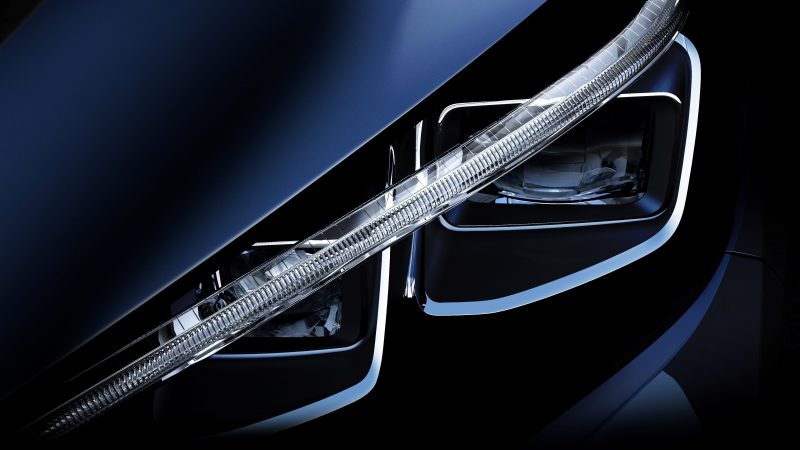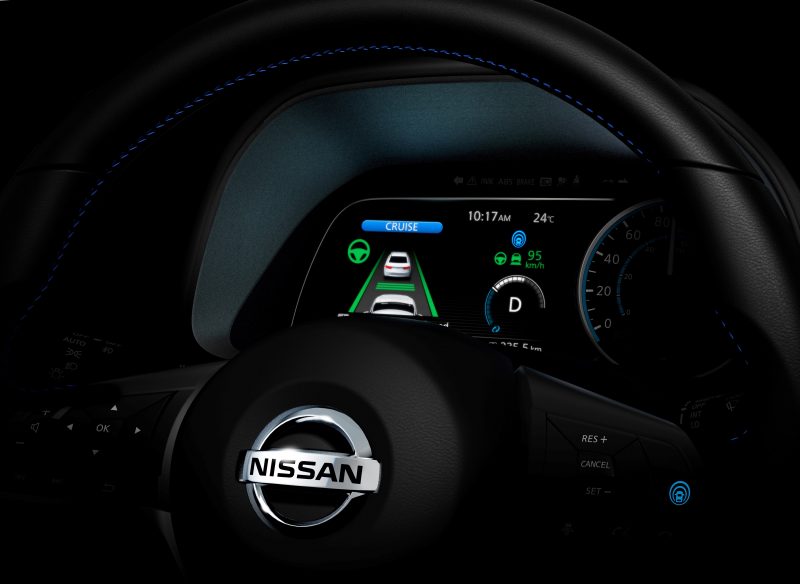Speculation is rife in this industry and while everyone clamours for some iota of information over another media brand, we’re not in that business and instead simply state the cold hard known and ratified facts. With this in mind, don’t get your hopes up to be told what battery capacity is in the new Nissan Leaf. We just don’t know for sure… yet. However, there are some solid facts that we do know about and we’re happy to share with you. The new Nissan Leaf is expected to be revealed on the 6th September 2017, so watch this space!
Fact 1.
The first teaser image revealed by Nissan shows the new Leaf’s headlight design. It is of similar design to the 2017 Nissan Micra and sports LED bulbs, that much is obvious. Whether it looks like the Nissan IDS concept (oft touted as the next Leaf’s concept car), there are similarities, yes, but that’s as far as it goes – namely the square lights behind an aerodynamic lens.
Fact 2.
Following the headlight image (bizarre choice of first reveal by the way), Nissan announced some of the new Leaf’s key features. This includes, “ProPILOT technology, enabling autonomous drive functionality in single-lane highway driving”. It’s worth remembering that press releases are examined before release, so there are a couple of things we can tell from this quote. Firstly, the new Leaf is unlikely to support full autonomous driving and the system will not initially support towns or cities. Nissan’s Dr Maarten Sierhuis, Director at Nissan Research Centre, Silicon Valley, himself said that autonomous vehicles will struggle with simple human problems like recognising road works and temporary traffic lights. His solution was to employ human call centres to do the work, which didn’t gain him too many favours in the quest for robotic autonomous driving. In addition, Nissan’s press release states, “the system [will] eventually [be] able to navigate city intersections”.
Gareth Dunsmore, Director of Electric Vehicles, Nissan Europe said: “The ultimate embodiment of Nissan Intelligent Mobility, the new Nissan LEAF will be the most advanced, accessible EV on the market, today. Adding ground-breaking ProPILOT technology to the new Nissan LEAF will prove invaluable in unlocking many of the benefits of electric vehicles, creating less congested, cleaner cities for future generations.”
As one would expect, ProPILOT does not replace the driver, but instead should be seen as an assistance or driver aid. In the Nissan promotional video, it details how the accelerator, brakes and steering are all assisted by the system. This can be activated or deactivated via a blue button mounted on the steering wheel.
Fact 3.
In the same ProPILOT press release mentioned above, Nissan gave us a first glimpse at the new Leaf’s steering wheel and dashboard. Take a look below. We’re extremely pleased to see the old silver buttons have been replaced with a much more grown up set, including volume control, four-way directional arrow controls plus ‘OK’ button, as well as cruise control settings and the new ProPILOT button.
In addition, we’re given a first glimpse of the dashboard instrumentation, which is surprisingly old fashioned in its approach with an analogue style gauge for speed and an inner circle set within it for – we assume – 0-100% power. Centrally mounted is the gear selection (D) and other information would appear here and/or to the left where the ProPILOT display is shown.
The display itself looks like it’s a full LCD screen, like that seen in Volkswagen’s e-Golf – and that’s no bad thing. It’s also full colour, as indicated by the screens shown, which means it’s likely maps and infotainment will also be displayed there for the driver’s benefit.
The column stalks still remain, including one for lighting and indicators and the other for windscreen wiping/washing.
Finally, the warning and information lights are mounted just above the dash within the binnacle, showing the parking brake, indicators, ABS, full beam, seatbelts unfastened warning, passenger airbag disabled indicator (important for those with kids) and battery (12V).
Fact 4.
The new Nissan Leaf will be equipped with advanced parking sensors as part of the ProPILOT package – titled ProPILOT Park. Like many systems that already exist, the driver should pass by spaces slowly and the car will sense and offer them as potential parking spaces. When the driver makes their selection, the car will manoeuvre into the space. This is instructed by pressing and holding down the ProPILOT button. Hey presto, you’re in the space. What’s not clear at this time is whether the ProPILOT Park or indeed the ProPILOT features are included with every Leaf.
Fact 5.
The new Nissan Leaf will sport a fancy new pedal that Nissan are calling a world first. In truth, it is described a lot like the BMW i3’s accelerator pedal, but there appears to be two major differences.
Firstly, it’s operated by a switch on the dashboard from what we can see in the video, meaning it can be disabled unlike in the BMW i3. Secondly, when it brings the car to a complete stop, it will engage either the brake or parking brake (we don’t know yet which) to hold the car on a hill.
Aside from that, if you want to go faster, press the accelerator like usual. If you want to slow down, release the throttle partially. If you want to come to a stop completely, release the pedal altogether.
https://youtu.be/zAZmx8pDalc

